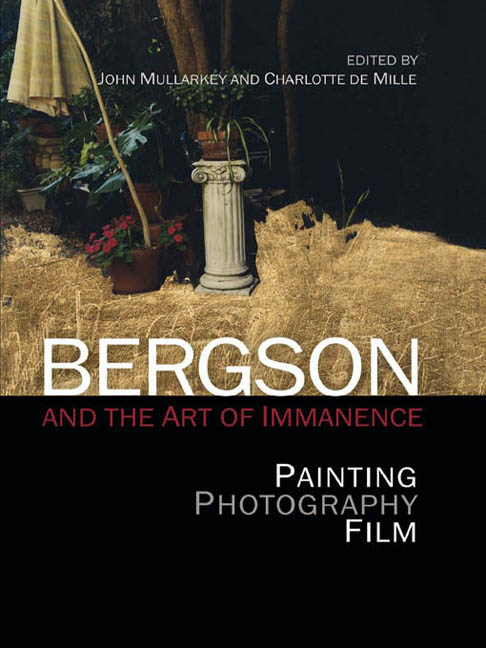Book contents
- Frontmatter
- Contents
- List of Illustrations
- Notes on Contributors
- Introduction: Art's Philosophy – Bergson and Immanence
- Part I Bergson, Art, History
- Part II Unconditional Practice
- 7 The Matter of the Image: Notes on Practice-Philosophy
- 8 Pasearse: Duration and the Act of Photographing
- 9 Duration and Rhetorical Movement
- 10 A Diagram of the Finite-Infinite Relation: Towards a Bergsonian Production of Subjectivity
- Part III Immanence of the Visible
- Afterword: An Art Historical Return to Bergson
- Index
8 - Pasearse: Duration and the Act of Photographing
from Part II - Unconditional Practice
Published online by Cambridge University Press: 07 December 2017
- Frontmatter
- Contents
- List of Illustrations
- Notes on Contributors
- Introduction: Art's Philosophy – Bergson and Immanence
- Part I Bergson, Art, History
- Part II Unconditional Practice
- 7 The Matter of the Image: Notes on Practice-Philosophy
- 8 Pasearse: Duration and the Act of Photographing
- 9 Duration and Rhetorical Movement
- 10 A Diagram of the Finite-Infinite Relation: Towards a Bergsonian Production of Subjectivity
- Part III Immanence of the Visible
- Afterword: An Art Historical Return to Bergson
- Index
Summary
The logic of expression seems to be one of duplication. Spinoza is too careful a grammarian to allow us to miss the linguistic origins of ‘expression.’ Attributes are, as we have seen, names: verbs, rather than adjectives. Each attribute is a verb, a primary infinitive proposition, an expression with a distinct sense; but all attributes designate substance as one and the same thing. The traditional distinction between the sense expressed and the object designated (and expressing itself in this sense) thus finds in Spinozism direct application.
Pasearse is a self-reflexive verb that could be translated as to ‘take oneself for a walk’. Walking as an artistic and intellectual practice has had a substantial trajectory within the history of painting and photography: from the early artists of the picturesque movement to the more contemporary ones, including the urban walks of the Situationists’ or those of the Land Art movement. For artists such as Richard Long and Robert Smithson, walking is central to the development of tactics, methods and practices that are confronted with the complexity of physical as well as mental activity. A verb lies at the heart of this; a practice made of walking. Even a line can go for a walk, as Paul Klee demonstrated, interlocking the semantic notions of active, medial and passive.
The photograph as a form of artistic expression contains not only the imprint or index of a recorded reality, but reflects the process of obtaining this image. This process, linked to time, is what makes the photograph unique compared to painting or sculpture, but not dissimilar to film. Whilst working on a series of images of trees in the landscape, I became interested in exploring the notion of photographic time as a quality beyond a dichotomy of before or after but rather as a reflexive state whereby landscape, photographer and camera all form and inform the very act of photographing. With the common denominator being defined through walking, the emphasis is placed on the fluid and instantaneous, the porous and limitless.
- Type
- Chapter
- Information
- Bergson and the Art of ImmanencePainting, Photography, Film, Performance, pp. 131 - 147Publisher: Edinburgh University PressPrint publication year: 2013

